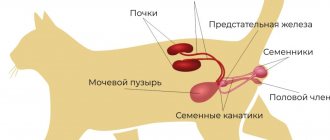Sterilizing a cat is a fairly complex surgical procedure. When deciding to have it performed, owners must fully assess all possible risks for the pet, and also be aware of all the nuances of the postoperative period. This will allow you to notice a problem in time, if it occurs, and take immediate measures to eliminate it.
The use of anesthesia when sterilizing cats is mandatory. How does the animal’s body react to this and how long does it take for the cat to recover from anesthesia ?
Preparing a cat for surgery
Almost all difficulties that arise in the postoperative period are in one way or another associated with weak immunity. Therefore, before the operation it is necessary to take some measures to strengthen it. No later than a month before the planned date of the operation, the cat should be vaccinated against various viral diseases, and 10 days before, the animal should be given a drug against helminths.
2-3 days before surgery, you need to donate the cat’s blood and urine for analysis, as well as do an ultrasound examination of the heart muscle and respiratory organs. On the day of the operation, the cat should not be given food under any circumstances, and 3 hours before the procedure, drinking is completely excluded.
Caring for an operated animal
High-quality post-operative care helps the cat return to normal much faster. And the owner won’t have to do anything “supernatural”:
- It is necessary to provide the cat with an unlimited amount of clean drinking water.
- We highly recommend keeping your pet in a separate room for at least the first few days, isolated from other animals and small children.
- Typically, your cat will need to wear a constriction corset or tight wrap (or surgical collar) for about two weeks.
- It is advisable to feed your pet saturated broths and high-quality canned food for at least the first two or three days.
Using anesthesia for cats
Many cat owners who care about the health of their pets are interested in how harmful anesthesia is for an animal. In general, all drugs that are used as anesthetics for animals are safe. They act quite gently on the cat’s body. The main thing is to choose the right dose, which directly depends on the size of the cat, as well as on the data obtained from the test results.
Before performing the operation, the specialist must evaluate the functioning of the heart, how stable it is and whether it will withstand anesthesia. No one can exclude the possibility of complications occurring during the operation, but it is quite possible to do everything to minimize these risks. If all measures aimed at preparing for surgery are carried out correctly and carefully, then the likelihood of complications occurring is almost zero.
Typically, contraindications for the use of anesthesia for a cat are its age (over 10 years), heart or respiratory disease, estrus period, and the presence of viral diseases. It is advisable to use anesthesia for a cat no more often than once a year. Thus, the load on the body will be quite normal.
What it is?
Sterilization, like vasectomy in cats, is a surgical method that involves the complete removal of a cat’s internal reproductive organs. Veterinarians strongly recommend castrating pets if the owner does not want to mate them and breed offspring. Otherwise, regular lack of mating negatively affects the cat’s health, causing dangerous complications. First of all, the cat’s hormonal levels are disrupted, increasing the risk of developing dangerous diseases such as inflammation of the uterus, decreased immunity, and oncology.
Modern surgery allows you to sterilize a cat with minimal tissue trauma. A seamless method is often used, in which the length of the incisions does not exceed 1 cm.
Cat's reaction to anesthesia
Immediately before the operation, before the introduction of anesthesia, it is possible to administer special sedatives. This is usually done to minimize stress on the animal. The most commonly used anesthetic drug is Propofol, but other drugs can also be used. The time it takes for a cat to fall asleep after the administration of an anesthetic may vary; it ranges from 10 to 30 minutes.
In addition to anesthetics, muscle relaxants are also used to immobilize cats, which promote additional muscle relaxation. To assess the cat's condition, it is connected to special sensor devices. This allows you to promptly notice any deviations and correct actions if necessary. The cat can remain under anesthesia from one to three hours, depending on the complexity of the operation.
Radiation sterilization
This method of sterilization is the targeted effect of radioactive isotopes on the gonads of females.
Advantages:
- no anesthesia;
- painlessness;
- no need for postoperative rehabilitation care;
- high efficiency.
Some experts suggest that radiation exposure may further provoke the development of cancer of the reproductive organs. However, there are no statistical data to support this claim yet.
The disadvantages of this method include its high cost and inaccessibility, since only a large, reputable clinic can afford expensive equipment for its implementation.
How long does it take for a cat to recover from anesthesia?
How long it takes for a cat to wake up from anesthesia depends on many factors. This, in addition to the physiological characteristics of the animal’s body, is also influenced by the drug that was used as anesthesia.
Outbred cats recover from anesthesia faster than purebred cats. Experts explain this by the fact that purebred pets have a weaker immune system compared to their mongrel counterparts. The worst recovery after anesthesia is Siamese, British, Bengal or Sphynx.
The age of the cat, as well as its general health, also have a significant influence on the speed of recovery from anesthesia. This is quite logical, because with age, various chronic diseases appear that have a direct impact on the general condition of the body. The average time for a cat to awaken from anesthesia is from 2 to 8 hours. A longer recovery is also considered acceptable, but this is the exception rather than the rule.
Indications
Early sterilization of stray cats must be carried out. In cats, early castration is preferable. This makes it possible to prevent the uncontrolled reproduction of street animals. Cats that cannot give birth due to health reasons or medical contraindications should be castrated. Pets with various genetic congenital abnormalities must be sterilized. Partial or complete removal of the reproductive organs is carried out if the owner does not intend to breed offspring and organize matings of the animal.
Oriental cat breeds, such as Thai and Siamese, have very high hormonal levels, which means there is a high risk of developing polycystic ovary syndrome, uterine and mammary cancer, and inflammation of the reproductive system. Therefore, if professional breeding of the breed is not planned, sterilization of Thai and Siamese cats is necessary.
Cat behavior after waking up
The first time after anesthesia, the cat is usually in the hospital. Specialists periodically check the functioning of the heart to prevent complications. The first day after waking up, the animal is in a state of half-asleep and its coordination is completely impaired.
After some time, the cat will try to get up, but she will not be able to walk normally, no matter how hard she tries. The paws may not obey and move to the sides. This condition can frighten the cat and cause it to become aggressive. If nothing threatens the safety of the animal, then it is better not to touch it at this time.
Later, aggression will be replaced by apathy, while the cat will still stand unsteadily on its feet. At this time, you can pet your pet and talk to her to reduce fear and tension. Perhaps, due to the anesthetic, the cat will not be able to blink at the required frequency for some time. Therefore, it may be necessary to periodically instill eyes with special drops.
There is no clear answer to the question of how long it takes a cat to recover from anesthesia In this case, no rules apply. This depends on a large number of different factors and, first of all, on the animal itself. The main thing during this period is to be close to the cat and try to help her as much as possible.
Possible complications
If the owner wants to help the pet and speed up recovery from anesthesia, but the cat does not come to its senses for a long time, the following consequences may arise:
A long-term unconscious state of a pet can be caused by heart failure.
- Heart failure. It is characterized by a sharp decrease in heart function, which leads to insufficient blood supply to tissues and hypoxia.
- Brain swelling. Occurs due to hypoxia and can be fatal.
- Decreased respiratory activity. The condition is associated with a slowdown in all processes in the body.
The owner should pay attention to warning signs, such as:
- The cat is cold and its temperature does not rise.
- The pupil does not react to light.
- Breathing is almost imperceptible, even if you hold a mirror to your pet’s mouth.
- The cat is vomiting after castration, and the cat is constantly vomiting.
- Heavy, hoarse breathing.
- Cramps.
- Unsteady, “drunk” gait after 5 days or paresis of the hind legs.
- Constipation or diarrhea.
- Urine or feces mixed with blood.
- Significant increase in temperature, refusal of food and water.
If there are pathological symptoms, your pet needs serious medical attention.
This condition can occur within a week, so the animal needs constant supervision by the owner. If bad symptoms are observed, you should urgently take the cat to the veterinary clinic, since intensive therapy cannot be carried out at home. You should also see a doctor if your pet is bothered by the stitch: there is an unpleasant odor, bloody or purulent discharge, or the stitch is coming apart.
Transportation, worming
Veterinarians recommend worming twice a year. Before sterilization, it must be carried out ten days before. But if the procedure was performed less than four weeks ago, there is no need to repeat it.
When sterilization is performed in a hospital setting, you need to take care in advance about the further transportation of your pet. You need to prepare a carrier, put a soft cloth and a diaper there. When recovering from anesthesia, the cat may injure itself and will not control urination.
Take a large carrier. You can also use a spacious basket or sports bag instead. The operated animal is prohibited from curling up in a ball after surgery. When the manipulation is performed in cold weather, the cat must be covered with a warm blanket during transportation.
Also read the article about caring for a cat after sterilization and what to feed it.
Arrangement of a resting place
At home, a four-legged patient needs a special place to rest and sleep. Choose the quietest corner in the apartment, where there are no drafts and crowds of people are kept to a minimum. Lay a blanket directly on the floor, covering it with disposable diapers on top. It is highly not recommended to place the animal on a sofa or chair, because After anesthesia, the cat’s reactions are inhibited, and it can fall from an elevation, damaging its limbs. Cover your pet with a blanket while sleeping.
Place a bowl of water next to the bed. A little later you can bring food. Also place a tray nearby, but be prepared for the fact that the animal may go to the toilet under itself.
Painkillers
The first 2 days after surgery are the hardest for your cat, so you can make her life easier. Signs that a cat is in pain are: increased aggression or apathy, the cat refuses food, looks at one point, once again tries not to move, dilated pupils. Analgesics relieve pain; cats are often given Ketoprofen, Tolfedin, Ainil, Previcox, Ketofen, Loxicom and other drugs. Analgin and no-spa are used less frequently, and paracetamol is completely dangerous to the health of the animal. The dosage is prescribed by the attending physician, and it is also a good idea to read the instructions.
If you cannot give an injection, part of the dose can be taken orally; therapy lasts 2-4 days. An hour after you have administered the anesthetic, you can begin to treat the sutures. Of course, there are animals with a high pain threshold that practically do not feel discomfort, but this is rare, so the use of analgesics is mandatory!











